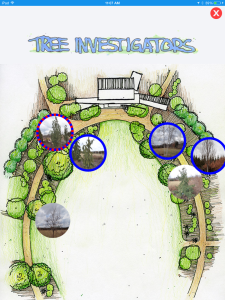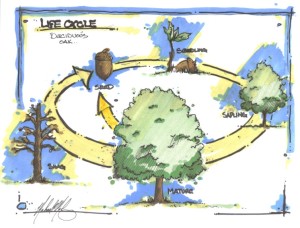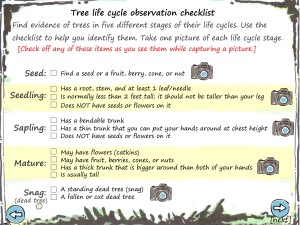Transforming Outdoor Places into Learning Spaces: Using Augmented Reality to Support Place-Based Learning
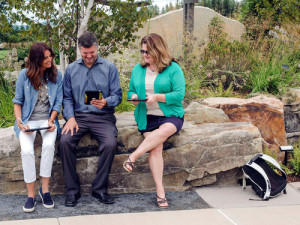
Land (Left), Millet (center), & Zimmerman (Right) at the PSU Children’s Garden. Photo Credit: Katie Bohn
This research is funded by the National Science Foundation (2018-2021). This project develops and examines place-based learning using mobile augmented reality experiences for rural families where museums and science centers are scarce yet where natural resources are rich with outdoor trails, parks, and forestlands. The collaborative research team, with members from rural libraries, outdoor learning centers, learning scientists at Penn State University, and rural communities in Pennsylvania, will develop augmented reality and mobile learning resources for families and children aged from 4 to 12. The goal is to help people see what is not visible in real-time in order to learn about life and earth sciences based on local watersheds, trees, and seasonal cycles that are familiar and relevant to rural communities.
Link to award announcement and abstract from the NSF
Link to Penn State news story
Research on Tablet Computers and iBeacons to support place-baed learning in Penn State Public Spaces
Heather Zimmerman (LDT), Chris Millet (Asst. Director, ETS), and I were funded in January 2015 by Penn State’s Center for Online Innovation in Learning (COIL) to investigate using iBeacons and other mobile technologies to support place-based learning in Penn State’s public spaces. The development effort for the project was led by Chris Millet and Penn State ETS to test an integrated CMS for context-sensitive learning called PLACES. Research stemming from this project led to a new partnership with Penn State’s Teaching and Learning with Technology to use augmented reality to support informal, place-based science learning outdoors. This research, funded by the Center for Online Innovation in Learning, involved prototyping and testing a series of app-based tours to support children to explore science within the Penn State Arboretum that were customized to particular locations, objects, and specimens within the various gardens. We assume that place serves an important role in learning by establishing a common ground that binds people, communities, histories, social interactions, interests, and conversations in meaningful ways (Oppeggard, 2014). This project investigated the design of digital learning resources to support tangible explorations of the Penn State Arboretum that were responsive to proximities to objects (Feki et al., 2013). Our goal was to focus children’s observations and conversations about science through a virtual layer of contextually-sensitive science resources. The project sought to create opportunities for learning in ways that blended location, other people, physical objects, and digital, mobile media in innovative ways.
• CUBeacon news story (2015): https://blog.cubeacon.com/how-ibeacon-technology-works-on-the-arboretum-at-penn-state.html
• PSU IT News story on the project: https://news.it.psu.edu/article/learning-beneath-trees
• RFID Journal News Roundup, “Penn State researchers use Gimbal Beacons to create interactive learning spaces”. http://www.rfidjournal.com/articles/view?13513/5
• COIL announcement. http://coil.psu.edu/blog/using-ibeacons-mobile-technologies-and-multi-touchfoil-displays-to-support-new-forms-of-community-engagement-and-learning-in-penn-state-public-places/
• YouTube Video of Land discussing the project: https://www.youtube.com/watch?v=AFTL55slSbk

Photographing evidence of tree fruit. Photo: Katie Bohn
Case Study 1: Exploring the biodiversity of Tree Fruit. We tested iBeacon-triggered digital resources designed and delivered via Places at the Penn State Arboretum during a field trip event with over 80 fourth graders. Our project sent children on a “way finding” activity throughout the arboretum to observe biodiversity of trees’ fruit, and photograph evidence of their observations by visiting trees augmented by Gimbal iBeacons. The iBeacons deployed as designed, and we will soon be writing up the results of our findings.
An abstract of our findings is below:
This research employs bluetooth low energy (BLE) iBeacon technology to create opportunities for youth to engage in place-based learning in a university arboretum. Our work conceptualizes how proximity-based technologies enable youth to engage in fine-tuned, localized observations and conversations about science in their community. We situate our work within three literatures: Learning outside of school, place-based learning, and context-sensitive mobile learning to inform the design of IoT systems to support scientific observations in outdoor spaces. We present data from an iBeacon-enabled mobile learning experience to support wayfinding and learning about the biodiversity of tree fruit with 84 youth (4th graders) participating on a school field trip. Data collected include log files, observational field notes, and learners’ photographic artifacts of their observations. Our findings point to personalized routes learners used to navigate the space, usability considerations, and evidence of learners making accurate observations and connecting observations to broader scientific ideas such as tree life cycles. We seek to provide insights into learner-centered mobile computing experiences that move beyond providing just-in-time content to creating a blended physical-digital space to support learners to engage with technology, each other, and natural objects in their local environment.
Case Study 2: Exploring local hydro-geological concepts of land-water transformation in a Children’s Garden. We created a second learning tour for the PSU Arboretum using iBeacons in the Children’s Garden. We ran a multi-day research study with 26 children (ages 6-10) to explore how water and land transform each other within Karst geological landscapes like those found in our local Central PA region. Specifically, we focused on how caves and sinkholes form by fostering playful learning experiences for children to explore, represent, connect, and create models of interacting local landscape features like groundwater, surface water, limestone rock, and our local watershed. We used iBeacons for one part of the study to support children to explore several physical models of our local geology that were present in the Children’s Garden: limestone and sandstone rocks, model cave, dry stream bed, model stream, and sculptures of fossilized coral. We used the beacons to trigger mobile resources that illustrated what these physical models represent geologically and how they are all connected in the formation of our local landscape.
Tree Investigators: Using Augmented Reality and Mobile Computing to Support Scientific Observations and Explanations Outdoors.
Tree Investigators is an augmented reality and mobile learning research project that we are conducting in conjunction with informal learning institutions — including the Arboretum at Penn State and Shaver’s Creek Environmental Center. We analyze video records families using mobile technologies with naturalists to understand how mobile devices support science talk related to tree biodiversity and tree life cycles. Our conceptual framework brings together research on technological supports for science learning and research on strategies that encourage families to engage in conversations that support observation and explanation practices.
Abstract of Findings (Land & Zimmerman, 2015, Socio-technical dimensions of an outdoor mobile learning environment: A three phase design-based research investigation).
This design-based research project examines three iterations of Tree Investigators, a learning environment designed to support science learning outdoors at an arboretum and nature center using mobile devices (iPads). Researchers coded videorecords and artifacts created by children and parents (n = 53) to understand how both social and technological supports influenced observations, explanations, and knowledge about trees. In Iteration 1, families used mobile devices to learn about tree characteristics and identification in an arboretum; in Iteration 2, families used our mobile app about trees’ life cycles and completed a photo-collage task documenting life cycle phases; Iteration 3 used a refined version of the Iteration 2 mobile app with children at a nature center summer camp, along with customized tools embedded into the app for documenting photographic evidence of tree life cycle phases in the forest. Findings suggested: (a) learners engaged in science talk representing observation and explanation practices (perceptual, conceptual, connecting, affective talk), and varying learning conversational patterns emerged based on refinements to design implementations; and (b) making connections between concepts introduced on the mobile app and application of them outdoors was challenging for learners without explicit social and/or technological support during identification tasks; specifically, appropriation of scientific vocabulary, noticing relevant features, and accu- rately identifying life cycle stages needed structured, on-demand support. Findings point to empirically-based implications for design of socio-technical supports for mobile learning outdoors.
Use of narrative and a comic-strip animated agent to support young children’s learning of science outdoors
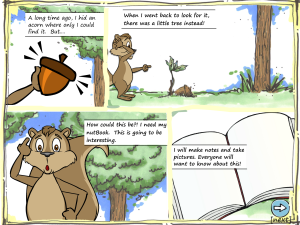 This dissertation research by Brian J. Seely investigated the role of a narrative story and animated agent (“Nutty the Squirrel”) to support young children to observe scientifically outdoors. Findings showed gains in children’s knowledge scores related to tree life cycles, evidence of affective engagement and situational interest, and developing trajectories of scientific vocabulary use during the outdoor learning experience.
This dissertation research by Brian J. Seely investigated the role of a narrative story and animated agent (“Nutty the Squirrel”) to support young children to observe scientifically outdoors. Findings showed gains in children’s knowledge scores related to tree life cycles, evidence of affective engagement and situational interest, and developing trajectories of scientific vocabulary use during the outdoor learning experience.
Online Affinity Spaces as Cultures for Informal Learning
 This research, undertaken with colleagues Priya Sharma (PSU), Brian Smith, and Jeff Swain, investigate informal learning within online social networks that emerge organically based on interests, hobbies, or affinities of users. Our research investigates the discourse within online spaces such as Fantasy Basketball leagues, online communities of runners, or Type II Diabetes social networks to identify knowledge sharing and knowledge building practices. We seek to identify new insights into learning by studying the self-initiated learning processes (Barron, 2006) and repertoires of practice (Nasir et al., 2014) that emerge and develop through interaction with the social and material resources of the network.
This research, undertaken with colleagues Priya Sharma (PSU), Brian Smith, and Jeff Swain, investigate informal learning within online social networks that emerge organically based on interests, hobbies, or affinities of users. Our research investigates the discourse within online spaces such as Fantasy Basketball leagues, online communities of runners, or Type II Diabetes social networks to identify knowledge sharing and knowledge building practices. We seek to identify new insights into learning by studying the self-initiated learning processes (Barron, 2006) and repertoires of practice (Nasir et al., 2014) that emerge and develop through interaction with the social and material resources of the network.
Link to 2019 ETR&D Publication: Sharma, P., & Land, S.M. (in press). Patterns of knowledge sharing in an online affinity space for diabetes.

